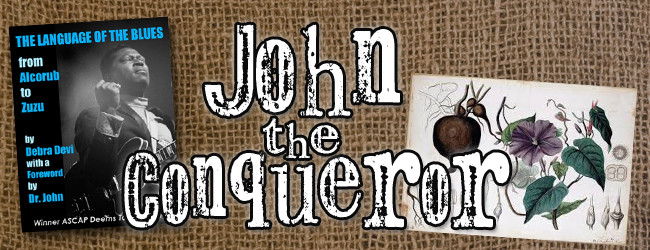This is the latest installment of our weekly series, The Language of the Blues, in which author/rocker Debra Devi explores the meaning of a word or phrase found in the blues.
Grab a signed copy of Devi’s award-winning blues glossary The Language of the Blues: From Alcorub to ZuZu (Foreword by Dr. John) at Bluescentric.com. Also available as an eBook from Amazon Kindle.
 John the Conqueror root has been a staple of hoodoo magical practices since the 1850s. The root is wrapped in Jack balls, carried in mojo bags and pockets, and chewed up and spat to activate spells.
John the Conqueror root has been a staple of hoodoo magical practices since the 1850s. The root is wrapped in Jack balls, carried in mojo bags and pockets, and chewed up and spat to activate spells.
Root doctors distinguish three types of John the Conqueror Root: High (or Big), Low, and Chewing John.
There is some dispute as to which plant is actually used as High John, probably because root doctors rely on whatever is available locally. The woody root of a morning glory, Ipomoea purga, is most commonly used. It originated in Xalapa, Mexico, where it is also known as jalapa. When dried, the roots resemble the testicles of a dark-skinned man, which may account for their inclusion in mojo bags and sexual spells. Low John is typically the root of the trillium wildflower, or wakerobin, (Trillium grandiflorum).
Chewing John, sometimes called Little John, is galangal (Alpina galanga). According to hoodoo expert Catherine Yronwode , “It is a member of the ginger family and is also used to treat stomachaches. In hoodoo practice, its pleasant gingery taste is part of its charm and, unlike High John and Low John, Chewing John is actually chewed and the juice swallowed.” Chew the root, swallow the juice, and discretely spit the cud onto the courtroom floor before the judge walks in, and he will decide the case in your favor.
The origins of the name “John the Conqueror” are unclear. John the Conqueror root may be named for a mythical man who ripped off the Devil’s arm and beat him silly with it. Another theory is that John the Conqueror was the son of an African king who was enslaved and brought to America, yet never let his spirit be broken. Instead, he undermined his master with clever tricks, and inspired other slaves to do the same.
According to interviews that folklorist Harry Middleton Hyatt conducted with hoodoo practitioners in the 1930s, John the Conqueror’s reputation as a trickster was so great that just reciting his name was protection against being hoodooed. Some linguists think his name may be a derivation of the Bantu word kankila, which means “to tremble with fear.”
To learn much more about how to use this hoodoo spell, check out the John The Conqueror entry in >The Language of the Blues: From Alcorub to Zuzu.
Songs:
“Mannish Boy” – Muddy Waters
“Hoochie Coochie Man” – Muddy Waters
“My John The Conquer Root” – Willie Dixon
Pick up a copy of Language of the Blues
Video:
Muddy Waters – “Mannish Boy”


